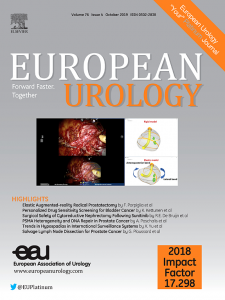高危前列腺癌强化新辅助治疗后残留癌负担的长期结局和预后影响
IF 25.3
1区 医学
Q1 UROLOGY & NEPHROLOGY
引用次数: 0
摘要
背景与目的对于高危局限性前列腺癌(HRLPC),根治性前列腺切除术(RP)前采用雄激素剥夺疗法(ADT)和雄激素受体途径抑制剂(ARPI)进行新辅助治疗(NAT)后的长期预后和残留病变程度的影响尚不清楚。方法:我们分析了2006年至2018年在我院进行的5项评估6个月ARPI NAT治疗HRLPC的试验的患者数据。残余癌负荷(RCB)是根据原发肿瘤的细胞结构调整后计算出的肿瘤体积。根据常规影像学,主要终点是无转移生存(MFS)。我们使用Contal-O 'Quigley方法对RCB分类进行了探讨,以区分MFS的高风险组和低风险组。在218例符合条件的患者中,诊断时中位前列腺特异性抗原为8 ng/ml, 42例(20%)患有cT3-4疾病,154例(71%)活检Gleason评分为8 - 10。在RP时,24例(11%)有病理完全缓解,中位RCB为0.05 cm3(四分位数范围为0.00-0.32)。中位随访5年,45例患者发生转移,11例死亡;5年MFS率为83%(95%可信区间[CI] 77-88%)。在多变量分析中,较高的RCB与较差的MFS相关(风险比1.21,95% CI 1.01-1.47)。RCB-0(病理完全缓解或无残留疾病)、RCB-1 (0.003 cm3)、RCB-2 (0.003 - 0.672 cm3)和RCB-3(≥0.672 cm3)患者的5年MFS率分别为100%、90% (95% CI 72-97%)、82% (95% CI 73-88%)和63% (95% CI 40-79%)。关键的限制是缺乏验证队列。结论和临床意义HRLPC患者在RP前接受ARPI NAT治疗的5年MFS率为83%。病理反应的深度,评价为RCB,是MFS的高度预后。RCB可用于指导HRLPC的NAT和NAT后佐剂试验。本文章由计算机程序翻译,如有差异,请以英文原文为准。
Long-term Outcomes and Prognostic Impact of Residual Cancer Burden After Intensified Neoadjuvant Therapy in High-risk Prostate Cancer
Background and objective
Long-term outcomes and the prognostic impact of the extent of residual disease after neoadjuvant therapy (NAT) with androgen deprivation therapy (ADT) and an androgen receptor pathway inhibitor (ARPI) before radical prostatectomy (RP) for high-risk localized prostate cancer (HRLPC) are not known.Methods
We analyzed data for patients treated in five trials evaluating 6 mo of ARPI NAT for HRLPC at our institution between 2006 and 2018. Residual cancer burden (RCB) was quantitated as the calculated tumor volume adjusted for cellularity in the primary tumor. The primary outcome was metastasis-free survival (MFS) according to conventional imaging. We explored RCB categories using the Contal-O’Quigley method to distinguish high- and low-risk groups for MFS.Key findings and limitations
Among 218 eligible patients, median prostate-specific antigen at diagnosis was 8 ng/ml, 42 (20%) had cT3–4 disease, and 154 (71%) had a biopsy Gleason score of 8–10. At RP, 24 (11%) had a pathologic complete response and median RCB was 0.05 cm3 (interquartile range 0.00–0.32). By median follow-up of 5 yr, 45 patients had developed metastases and 11 died; the 5-yr MFS rate was 83% (95% confidence interval [CI] 77–88%). On multivariable analysis, higher RCB was associated with poorer MFS (hazard ratio 1.21, 95% CI 1.01–1.47). The 5-yr MFS rates were 100%, 90% (95% CI 72–97%), 82% (95% CI 73–88%), and 63% (95% CI 40–79%) for patients with RCB-0 (a pathologic complete response or no residual disease), RCB-1 (<0.003 cm3), RCB-2 (0.003–0.672 cm3), and RCB-3 (≥0.672 cm3), respectively. The key limitation is lack of a validation cohort.Conclusions and clinical implications
The 5-yr MFS rate for patients treated with ARPI NAT before RP for HRLPC was 83%. The depth of pathologic response, evaluated as the RCB, was highly prognostic for MFS. RCB could be used to guide NAT and post-NAT adjuvant trials in HRLPC.求助全文
通过发布文献求助,成功后即可免费获取论文全文。
去求助
来源期刊

European urology
医学-泌尿学与肾脏学
CiteScore
43.00
自引率
2.60%
发文量
1753
审稿时长
23 days
期刊介绍:
European Urology is a peer-reviewed journal that publishes original articles and reviews on a broad spectrum of urological issues. Covering topics such as oncology, impotence, infertility, pediatrics, lithiasis and endourology, the journal also highlights recent advances in techniques, instrumentation, surgery, and pediatric urology. This comprehensive approach provides readers with an in-depth guide to international developments in urology.
 求助内容:
求助内容: 应助结果提醒方式:
应助结果提醒方式:


